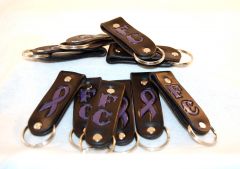Next up we I take the leather with lubricated edges (from the saddle soap) over to my dremel burnisher. This makes it super quick and easy, but doing it by hand works too. I use the back channel on this one because it fits the profile of the leather better. Yes, I know, I need to clean my burnisher
These next two shots are attempting to show the burnished look of it with a bad cell phone picture.
Since I wasn't getting a good shot, I decided to offer some contrast and put some dye on the edge. I just splashed some dye onto my blue shop paper towel (as tom explained earlier) and rubbed it on. See how the dye pretty much stopped solid on the line? That's because the burnished edge doesn't allow it to bleed past it. I also briskly buffed it up with the dirty side of my denim scrap. Dirty as in, it's already got black streaks on it. I should also add that I really didn't take any time to make sure I had good dye coverage on it since I was just going for contrast to show in the pictures. Had this been a real project, I would have use a sponge or foam brush to get good coverage, or at least worked a touch longer on applying it with the rag. This was just a QUICK rub down.
Here's our "finished" result. I have wax loaded into that denim pretty good, so I rub it in and then get a non-waxed portion of the denim to quickly rub at the edge and cause friction. This makes for a super smooth and shiny edge that you can hardly tell was once two pieces. Now, if I were putting Resolene or other finish on, I would do it before waxing. Other than that, my process is the same. As I said, this entire thing took about 5 minutes, with a lot of that stopping to take pictures over and over until I got a clear one
I usually just leave that natural and give it a quick rub with my bone folder to slick it up a little. If the customer requests that I color it, I'll brush some in there. You'll also find that Sharpie can work wonders here
I don't do any texting or anything, but this method is working fine.
















